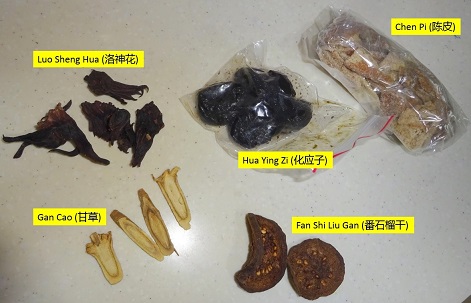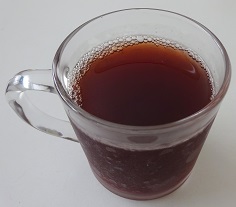| Home | Nature Weekly Index |
10 May 2015 | Roselle Concoction (Hibiscus sabdariffa) |
 Lately, I have been drinking a maroon colour solution brewed from a concoction of pre-packed parts from different plants preserved
in different forms. According to the label on the pack, the mixture was named Roselle Teabag and from Taiwan. The so called teabag
is actually a transparent ziplock bag. Preparation was relatively easy --- just poured the ingredients from the pack into half a
litre of water and boiled for 20 minutes. In all, there were 5 ingredients listed in Chinese:
Lately, I have been drinking a maroon colour solution brewed from a concoction of pre-packed parts from different plants preserved
in different forms. According to the label on the pack, the mixture was named Roselle Teabag and from Taiwan. The so called teabag
is actually a transparent ziplock bag. Preparation was relatively easy --- just poured the ingredients from the pack into half a
litre of water and boiled for 20 minutes. In all, there were 5 ingredients listed in Chinese:
- (1) Luo Sheng Hua (洛神花)
- (2) Chen Pi (陈皮)
- (3) Gan Cao (甘草)
- (4) Hua Ying Zi (化应子)
- (5) Fan Shi Liu Gan (番石榴干)
I did a further check on the ingredients and below were my findings:
- (1) Luo Sheng Hua (洛神花): This semi-dried ingredient formed the main bulk of the mixture, probably up to 80% of the content. It common English name is Roselle (Hibiscus sabdariffa).
- (2) Chen Pi (陈皮): Dried orange skin with salt added, at least in this pack.

- (3) Gan Cao (甘草): A Chinese herb commonly known as Licorice Root or Radix Glycyrrhizae. It is a herbaceous plant from the Bean Family (Fabaceae) with the botanical name Glycyrrhiza glabra. The part in used is the root of the plant, which is dried and sliced into thin layer.
- (4) Hua Ying Zi (化应子): The name is a short form for Hua He Jia Ying Zi (化核加应子) which means seedless plum. It is a small plum native to China known botanically as Prunus salicina. The preserved plum is black in colour and in a semi-dried form.
- (5) Fan Shi Liu Gan (番石榴干): This is simply dried Guava (Psidium guajava).
The maroon colouration of the drink is from the Roselle as well as the dark semi-dried plum. The salty and sour taste is mainly from the salted dried orange skin. The drink is rather refreshing especially serve cold or with ice cubes.